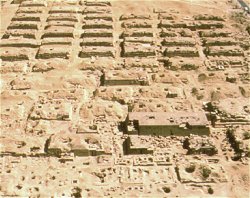
An Arabic word meaning 'bench', used to refer to a certain type of tomb whose superstructure (with slightly inclining walls) resembles the benches outside Egyptian homes. Tombs of this type consist of an underground burial chamber, sometimes with subsidiary rooms, hidden under and protected by a rectangular superstructure of stone or mudbrick. The superstructure contained an offering chamber, originally only a niche which later developed into a whole series of rooms connected by corridors. In the offering chamber was a false door and an offering table (see 'altar'); a statue of the deceased was placed in a closed-off room called the 'serdab'. A small opening in the wall of the 'serdab' enabled the statue to partake of the offerings.
In the Early Dynastic Period, mastaba tombs were built by kings and private individuals alike, among other places at Abydos and Saqqara. These mastabas had several underground rooms, divided from each other by walls but without doors. The superstructure could thus only be completed after the burial. Later tombs have a stairway (subsequently blocked by rubble or portcullis stones) leading to the burial chamber. Mastabas from the Old Kingdom can be found in all the large cemeteries, especially Giza, Saqqara, Abu Sir and Maidum. At this time mastabas were only built by private persons; the kings were being buried in pyramids, the first of which was the Step Pyramid of Djoser at Saqqara (3rd Dynasty), which in fact consists of six mastabas of decreasing size, one on top of the other. From this time on the number of subterranean chambers decreased, and by the 4th Dynasty only the burial chamber remained, linked with the superstructure by a shaft (filled with rubble). Private individuals also built mastabas in the Middle Kingdom, but gradually rock-cut tombs became more common.